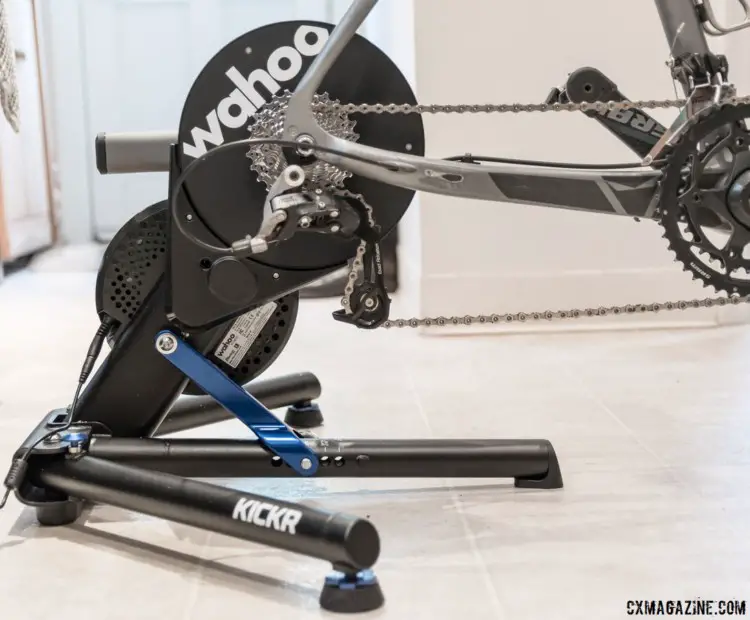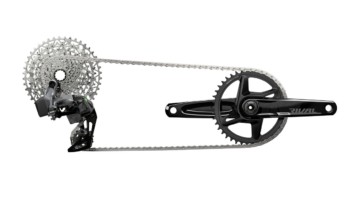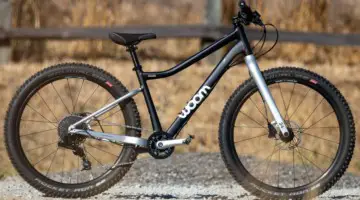Indoor training has its advantages, even if you live in an area with year-round mild weather. Smart trainers provide reliable power data to help you dial in your workouts and now, third-party apps allow you to ride or even “race” against other riders around the world, making indoor training motivation easier to find.
Direct-drive smart trainers, including the CycleOps Hammer and Elite Drivo, are becoming increasingly popular with consumers thanks to their large freewheels that offer “road-like” feel and compatibility with interactive training applications such as Zwift.
The Wahoo Kickr is one of the mainstays on the direct-drive smart trainer market. The Kickr was one of the first freewheel-based direct-drive trainers, so Wahoo has refined the unit over the years. The Kickr is compatible with most aftermarket training applications, and the company conveniently offers a chart describing the features each app provides. Wahoo even produces an optional device called the Kickr Climb that elevates or drops the front of your bike to simulate climbing or descending, adding elevated realism to your virtual training.
In an effort to keep my fitness high through the entire cyclocross season, I put the Kickr to the test over the past several months. This review reports back on my experience riding the Kickr paired with Zwift and Wahoo’s native training application.
The Wahoo Kickr Smart Trainer
The 47-pound Wahoo Kickr unit is steel and houses a 12.5-pound flywheel connected to the direct drive resistance mechanism via a belt drive. The tubular steel legs swing out from their storage positions and lock solidly in place and big leveling feet further stabilize the unit. The unit accommodates several wheel sizes using a hinged cantilever arm that supports the resistance unit and flywheel.
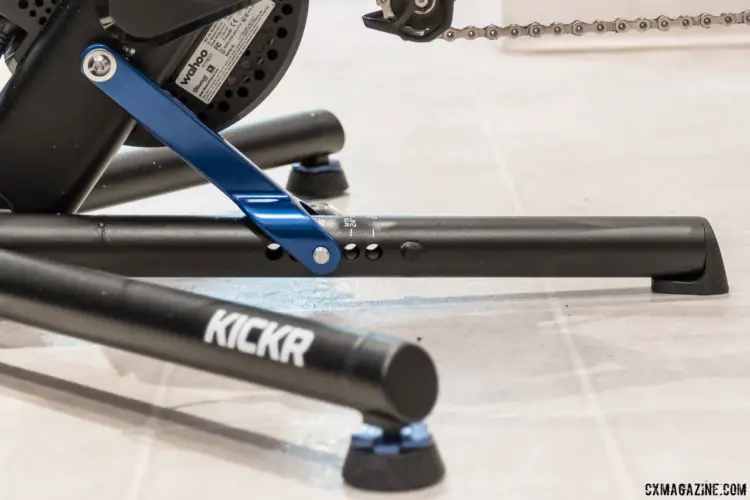
Three legs stabilize the Kickr and an adjustable arm provides room for several wheel sizes. Wahoo Kickr Direct-Drive Smart Trainer. © C. Lee / Cyclocross Magazine
The arm has marks for all popular wheel sizes, allowing for easy switching between your 24″ wheeled cruiser-class BMX bike, 29er mountain bike and everything in between. The unit also includes a well-placed handle with a rubberized grip to help with portability.
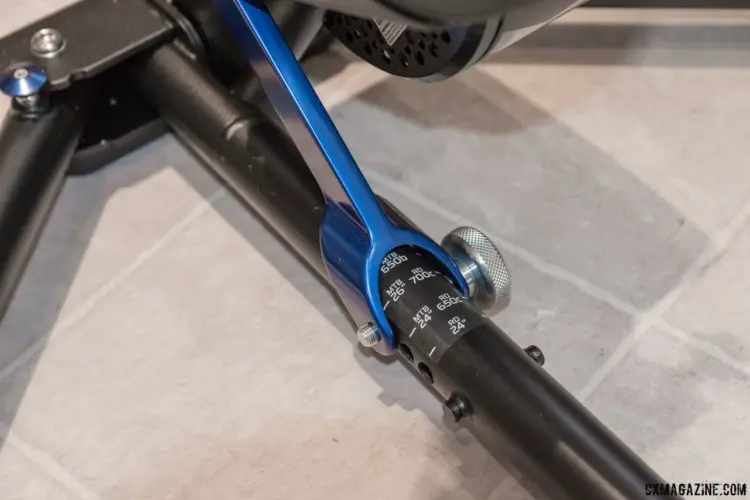
An adjustable arm provides clearance for a number of wheel sizes. Wahoo Kickr Direct-Drive Smart Trainer. © C. Lee / Cyclocross Magazine
One benefit of direct-drive trainers for cyclocrossers is they eliminate the need for a special wheel with a smooth tire. To use the Kickr, you remove the rear wheel and attach your bike’s drivetrain to a cassette installed on the unit’s 11-speed Shimano/SRAM freehub. The Kickr comes with an 11-speed 11-26t cassette, but it is also compatible with 8,9 and 10-speed cassettes using the included spacer.
The Kickr joins other direct-drive units on the market in offering compatibility for a variety of axle types and sizes. It supports road (130mm) and disc (135mm) quick release, 12x142mm thru-axle and 12x148mm boost axles. If you want to take your indoor training to a higher level, the Kickr is also compatible with Wahoo’s Climb unit that raises and lowers the front end to simulate climbing grades during your training.
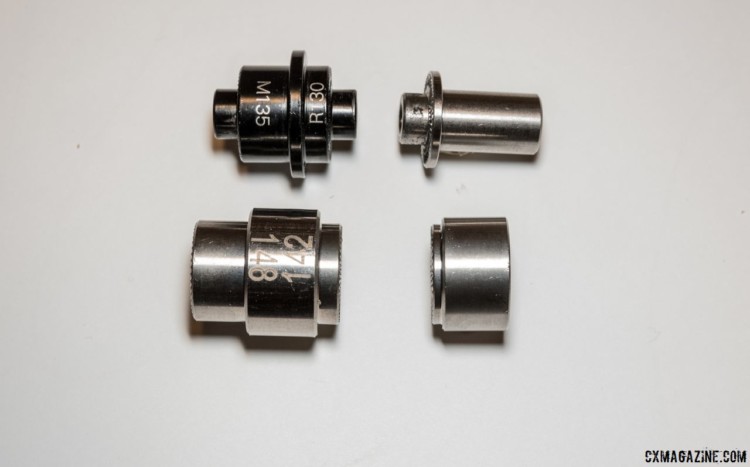
The Kickr comes with adapters for quick release and thru-axles. Wahoo Kickr Direct-Drive Smart Trainer. © C. Lee / Cyclocross Magazine
The Kickr communicates using Ant+, Ant+ FE-C and BlueTooth protocols, which allow it to connect to tablets, phones and PCs and interact with popular aftermarket training apps. In addition to the included cassette and spacer, the Kickr also comes with other thoughtful extras. A rear disc brake caliper spacer eliminates the risk of popping the piston off when you mount your bike to the trainer and an attachable cadence sensor provides additional ride data to assist with your training.
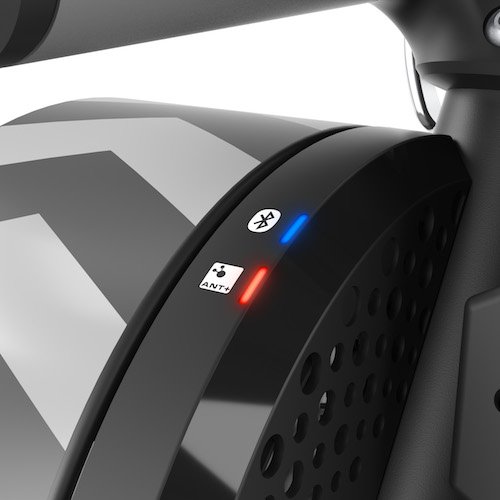
The Kickr is compatible with both Ant+ and Bluetooth. Wahoo Kickr Direct-Drive Smart Trainer. photo: Wahoo Fitness
Pre-race trainer warm-ups are popular in cyclocross, so as is the case with other direct-drive trainers, you will probably need a race-day compliment to the Kickr. It is heavy to transport, requires you to remove your rear wheel and cassette and requires a power source for resistance. If you upgrade to the Kickr, it is probably worth holding onto your “dumb” trainer if you plan on warming up on the trainer.
Aftermarket apps such as shine when used with the Kickr, but Wahoo also offers its native Wahoo Fitness app for use with the Kickr. Wahoo’s app is available for Android, iOS and PC and allows the user to control the Kickr’s resistance in different ways, including setting a constant resistance, resistance curve, power level or real-world grade or headwind.
Wahoo Kickr Ride Review
Given the dread many cyclocrossers express about indoor trainer season, it is fair to say the biggest appeal of smart trainers such as the Kickr is their ability to pair with third-party training applications that provide an interactive riding experience. I opted to use Zwift as my primary training tool, but other apps such as Rouvy, TrainerRoad and TheSufferfest, among others, are also available.
I was able to easily pair the Kickr with the Zwift app on my computer using an ANT+ dongle, and I also experienced little trouble pairing the included Wahoo cadence sensor and Wahoo Tickr heart rate monitor.
The Wahoo Kickr provided a realistic feeling while I was riding, even though the toughest weather I faced was the draft from my fan. The Kickr responded smoothly and seamlessly to the changes in power and resistance produced by the Zwift app. This “real” feeling got me addicted to Zwift rather quickly, and I soon found myself chasing down other riders and trying to drop them on the climbs.
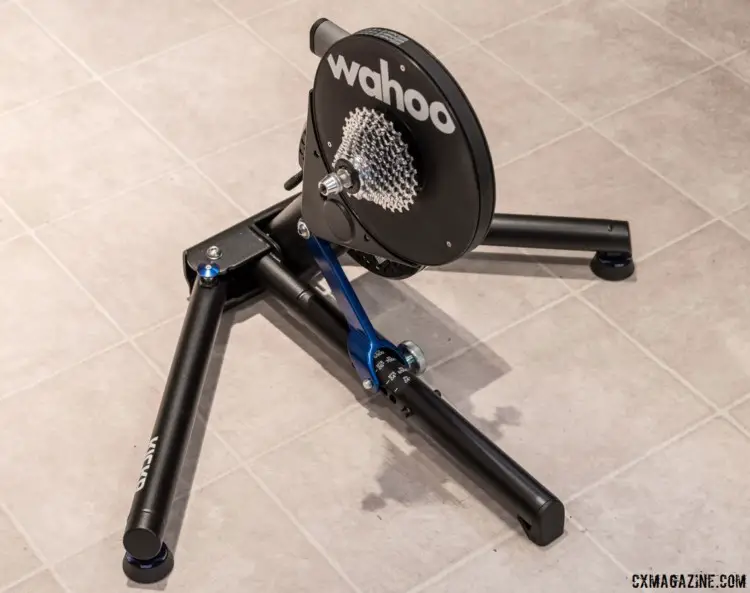
The Wahoo Kickr unit has a three-leg base, 12.5-pound flywheel and 11-speed hub. Wahoo Kickr Direct-Drive Smart Trainer. © C. Lee / Cyclocross Magazine
When it came to drop the hammer on the flats, the big 12.5-pound flywheel responded well to my big-ring cadence, aiding the smooth feeling. When I briefly coasted to reposition myself, resuming pedaling felt natural. One aspect of the ride experience challenged me was resuming pedaling while in the big ring and little cog after extended coasting or stopping. The direct-drive unit presented a significant amount of resistance I had to overcome to get back up to speed. This aspect of the ride experience was a minor inconvenience compared to the smooth, enjoyable resistance provided by the freewheel and direct-drive setup.
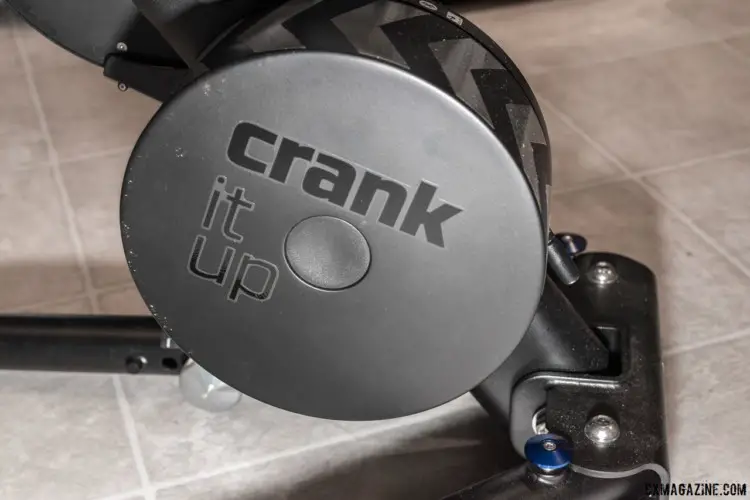
The Wahoo Kickr has a 12.5-pound flywheel to provide resistance. It also conveniently comes with instructions printed on the side. Wahoo Kickr Direct-Drive Smart Trainer. © C. Lee / Cyclocross Magazine
Users (and neighbors) are always concerned about trainer noise, although units like the Kickr have made huge strides in becoming quieter over the years. The Kickr has a claimed noise level of 61 decibels, which is similar to a semi-distant air conditioning unit or indoor conversation. The trainer produces a constant hum that I learned to block out soon after starting my indoor training time.
As mentioned above, the Kickr connects using both Ant+ and Bluetooth protocols, but I had more success with one versus the other. I initially had trouble connecting to Zwift using Bluetooth. The Bluetooth connection to Zwift dropped several times, causing my avatar to just stop on the side of the road before the trainer suddenly reconnected. I read through Zwift forums to research the issue, and it seems other smart-trainer users have had similar problems (not just with the Kickr). My problem was seemingly solved by switching to an Ant+ connection.
I never had a problem connecting to the Wahoo Fitness app using Bluetooth, so it seems mine might be a Zwift issue versus a Kickr issue. During our time reviewing smart trainers, our team has learned patience in dealing with issues such as this one is important when first using these training tools.
The Verdict
The $1200 Wahoo Kickr is an investment, but if you are short on training time or live in an area where year-round outdoor riding is merely a pipe dream, the Wahoo Kickr delivers in both ride quality and training app compatibility. The Kickr provides a smooth ride that feels about as life-like as one could expect from a trainer and extras such as the cadence sensor were nice additions that made it easy to kick off my trainer experience. Since smart trainers are really brought to life by third-party training apps such as Zwift, I appreciated that Wahoo provided some guidance on what the different choices have to offer.
Simply watching old race videos, TV shows or listening to music are not nearly as motivating as riding with others on-screen in real-time via Zwift, whether in a competitive fashion or not. As a cyclocross racer, it certainly offers some of the thrill of competition, which is a great motivator to get on the trainer, especially now that the excitement of the racing season is over. The Wahoo Kickr proved a worthy tool for getting the most out of my bad-weather training experience.
Wahoo Kickr Specifications
Cost: $1,200 MSRP
Weight: 47 lbs total with 12.5-pound flywheel (claimed)
Freehub: Shimano/SRAM 11-speed freehub, spacers included for 8, 9 and 10-speed compatibility
Axles: 130 and 135mm quick release, 12 x 142/148mm thru-axle
Power/Grade Range: Up to 20% grade, 2,000 watts at 20mph (claimed)
Noise: Claimed 61 dB at 20mph
Assembly: No tools required to assemble or store
More Info: wahoofitness.com













